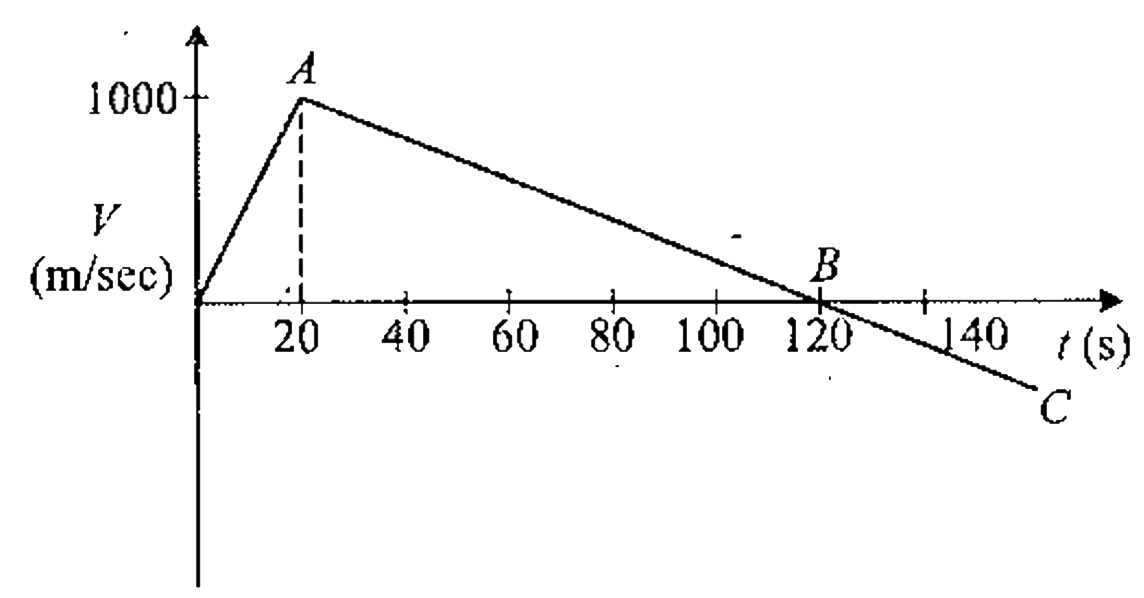A particle is thrown vertically upwards. If its velocity at half of the maximum height is 10 m/s, then maximum height attained by it is
8m
10m
12m
16m
The correct Answer is:B
To solve the problem, we need to find the maximum height attained by a particle thrown vertically upwards, given that its velocity at half of the maximum height is 10 m/s.
1. Understanding the Problem:
- We know that the particle is thrown upwards and reaches a maximum height H.
- At half of this height (H2), the velocity V is given as 10 m/s.
2. Using the Equation of Motion:
- We can use the third equation of motion, which is:
V2=U2+2as
- Here, V is the final velocity (10 m/s), U is the initial velocity (unknown), a is the acceleration (which will be −g or −10m/s2 since gravity acts downwards), and s is the displacement (H2).
- Rearranging the equation gives:
102=U2−2g(H2)
- This simplifies to:
100=U2−10H(Equation 1)
3. Finding the Initial Velocity U:
- Now we need another equation to express U in terms of H. We will use the same equation of motion for the entire height H:
0=U2−2gH
- Rearranging gives:
U2=2gH(Equation 2)
4. Substituting Equation 2 into Equation 1:
- Substitute U2 from Equation 2 into Equation 1:
100=2gH−10H
- Substituting g=10m/s2:
100=20H−10H
- This simplifies to:
100=10H
5. Solving for Maximum Height H:
- Dividing both sides by 10 gives:
H=10meters
Conclusion:
The maximum height attained by the particle is 10 meters.
- We know that the particle is thrown upwards and reaches a maximum height H.
- At half of this height (H2), the velocity V is given as 10 m/s.
- We can use the third equation of motion, which is:
V2=U2+2as
- Here, V is the final velocity (10 m/s), U is the initial velocity (unknown), a is the acceleration (which will be −g or −10m/s2 since gravity acts downwards), and s is the displacement (H2).
- Rearranging the equation gives:
102=U2−2g(H2)
- This simplifies to:
100=U2−10H(Equation 1)
- Now we need another equation to express U in terms of H. We will use the same equation of motion for the entire height H:
0=U2−2gH
- Rearranging gives:
U2=2gH(Equation 2)
- Substitute U2 from Equation 2 into Equation 1:
100=2gH−10H
- Substituting g=10m/s2:
100=20H−10H
- This simplifies to:
100=10H
- Dividing both sides by 10 gives:
H=10meters
The maximum height attained by the particle is 10 meters.
Topper's Solved these Questions
- MOTION IN ONE DIMENSIONBOOK - ERRORLESSCHAPTER - MOTION IN ONE DIMENSIONEXERCISE - PAST YEARS QUESTIONS
26 Videos
- MOTION IN ONE DIMENSIONBOOK - ERRORLESSCHAPTER - MOTION IN ONE DIMENSIONEXERCISE - ASSERTION AND REASON
24 Videos
- MOTION IN ONE DIMENSIONBOOK - ERRORLESSCHAPTER - MOTION IN ONE DIMENSIONEXERCISE - NCERT BASED QUESTIONS (RELATIVE MOTION )
18 Videos
- KINETIC THEORY OF GASES BOOK - ERRORLESSCHAPTER - KINETIC THEORY OF GASES EXERCISE - ASSERTION AND REASON
16 Videos
- MOTION IN TWO DIMENSIONBOOK - ERRORLESSCHAPTER - MOTION IN TWO DIMENSIONEXERCISE - ASSERTION & REASON
19 Videos
Similar Questions
A stone is projected vertically upwards.When it reaches half the maximum height,its velocity is 20m/s.What is the maximum height attained by the stone? (g=10m/s^(2)
View SolutionA ball is thrown vertically upward with a velocity of 20 m/s. Calculate the maximum height attain by the ball.
View Solution
Knowledge Check
A particle is thrown vertically upwards. If its velocity is half of the maximum height is 20m/s, then maximum height attained by it is
A25 mB30 mC35 mD40 mA particle is thrown vertically upward. Its velocity at half of the height is 10 m/s. Then the maximum height attained by it : -
(g=10m/s2)A8 mB20 mC10 mD16 mWhen a particle is thrown vertically upwards, its velocity at one third of its maximum height is 10√2m/s. The maximum height attained by it is
A20√2mB30mC15 mD12.8 m
A rocket is projected vertically upwards and its time velocity graph is shown in the figure-1.115. The maximum height attained by the rocket is :

View SolutionA stone is thrown vertically upwards with a velocity of 4.9ms−1. Calculate : the maximum height reached.
View SolutionA stone is thrown vertically upwards. When stone is at a height half of its maximum height, its speed is 10ms−1 , then the maximum height attained by the stone is (g=10ms−2)
View SolutionTwo bodies are thrown vertically upwards with their initial velocity in the ratio 2:3. Then the ratio of the maximum height attained by them is
View SolutionA ball is thrown vertically upward in air. When the particle is at a height half of its maximum height its speed is 10 m/s. Then the maximum height attained by the particle is
View Solution
